Research on the Creep Model of Deep Coal Roadway and Its Numerical Simulation Reproduction
Abstract
1. Introduction
2. Experimental Investigation
2.1. Preparation and Properties of Sample
2.2. Test Equipment
2.3. Test Plan
- (1)
- Wrap the dried coal sample with a rubber film (to prevent the fragments from falling apart after crushing, and to keep the original state of the test at the time of failure), and install the LVDT extensometer to measure the axial and lateral deformation;
- (2)
- Put the prepared specimen into the testing machine and adjust the center position of the sample so that the axis of the coal sample coincides with the loading center line of the testing machine to avoid eccentric pressure on the coal sample;
- (3)
- Fix the coal sample with a slight axial stress, and then apply axial stress and hoop stress (5 MPa) to a predetermined value in sequence. The first stage of stress is applied to the coal sample by the servo system, and the system automatically records the deformation value of the sample at that level of stress at the specified time interval. When the specified observation time is reached (the displacement under constant load is less than 0.001 mm/h), it enters the next level of stress test. The coal sample undergoes rheological failure under the action of the last stage of load;
- (4)
- Take out the coal sample, describe its failure mode, and sort out the test data.
3. Test Results and Discussion
3.1. Typical Creep Curve
3.2. Analysis of Test Results
3.3. Analysis of Rheological Characteristics
4. New Nonlinear Viscoelastic-Plastic Rheological Model Based on Fractional Calculus
4.1. Fractional Element
4.2. Nonlinear Viscoplastic Element
4.3. New Fractional Nonlinear Viscoelastic-Plastic Rheological Model
- (1)
- When , the model degenerates to a Burgers model with fractional derivatives, and its creep equation is:where , r is the fractional derivative, and is the initial viscosity coefficient of the Abel viscous pot.
- (2)
- When , the creep equation is:where is the instantaneous elastic strain; is the irrecoverable strain, which is viscous flow; and is the recoverable strain.
4.4. Model Parameter Identification
5. Secondary Development Based on Burgers Program Code
5.1. New Model Calculation Principle
- (1)
- For Kelvin:where, , denotes the partial strain and the first-order derivatives of partial strain with respect to time, respectively.
- (2)
- For Maxwell:
- (3)
- For Non-linear viscous-plasticity:
5.2. Key Technologies for Secondary Development
- (1)
- Visual Studio is used to create a solution (*.sln file) to develop the project (*.vcproj). The files shown in Table 2 are included in the UDM file provided with the software.
- (2)
- Add the source and header files for the custom constitutive model. It is not necessary to rewrite all of the code, and the function interfaces in the header and source files do not need to be modified. The user can make changes based on the source code and header files provided with the program. The modifications required are:
- Modify the registration number of the model;
- Modify the return name string of the custom constitutive model, which corresponds to the pointer to the string returned when the model is called with the MODEL command in the program;
- Modify the model name string;
- The clone function is modified to create a new object of the same class as the current object, returning a pointer to the Constitutive Model type, which must be the same as the name after the EXPORT function;
- Modification of lateral limit modulus function, bulk modulus function and shear modulus function;
- The definition of private variables: under the keyword PRIVATE, which defines the direct and indirect variables needed for the constitutive model.
- (3)
- After modifying and regenerating the solution, the DLL file will be generated in the Debug folder in the project folder. The model operations are called in the program for result verification, and the computational flow is shown in Figure 14 below.
5.3. Numerical Examples Validated
5.4. Creep Prediction of Surrounding Rock
6. Conclusions
- (1)
- When the stress level is low, the creep rate curve has a decay stage and a steady state stage, and the steady state creep rate tends to increase with the increase of the stress level; When the stress level is higher than the yield threshold, the creep rate curve can appear an acceleration stage after the decay stage and steady stage. During the creep process, the coal sample goes through the stages of crack compaction, elastic deformation, crack expansion, and macro fracture. The instability failure mode of the coal sample mainly consists of shear failure with local tension failure.
- (2)
- The NFNVRM capable of simulating the full process characteristics of coal sample creep was developed by introducing Abel elements and nonlinear viscous-plastic elements. The creep equation, rheological equation, relaxation equation, and unloading equation of the model were also derived. Based on the creep data, 1STOP software was used to identify each parameter of the model, and the fitted curves were in good agreement with the test curves. The NFNVRM provides the theoretical basis for engineering applications.
- (3)
- Based on the interface between FLAC3D software and Microsoft Visual Studio 2010 software (Microsoft Corporation, Redmond, WA, USA), the program of the NFNVRM constitutive model was compiled to generate a dynamic link library file. The program was called to simulate the triaxial compression creep, and the coincidence degree between the simulation curve and the experimental curve was more than 90%, which could well reflect the change of the whole creep process. The validity of the model was verified.
- (4)
- The deformation of the surrounding rock of a transport roadway in an S Mine was predicted for a long time, and the simulation results conformed to the creep law. Based on this, reasonable measures can be taken to avoid casualties and losses. The research results are of great significance for ensuring geological environment safety and social public health.
Author Contributions
Funding
Institutional Review Board Statement
Informed Consent Statement
Data Availability Statement
Conflicts of Interest
References
- Wu, C.; Chen, Q.; Basack, S.; Karekal, S. Laboratory investigation on rheological properties of greenschist considering anisotropy under multi-stage compressive creep condition. J. Struct. Geol. 2018, 114, 111–120. [Google Scholar] [CrossRef]
- Yu, X.Y.; Xu, T.; Heap, M.; Zhou, G.L.; Baud, P. Numerical approach to creep of rock based on the numerical manifold method. Int. J. Geomech. 2018, 18, 04018153. [Google Scholar] [CrossRef]
- Chen, C.; Xu, T.; Heap, M.J.; Baud, P. Influence of unloading and loading stress cycles on the creep behavior of Darley Dale Sandstone. Int. J. Rock Mech. Min. Sci. 2018, 112, 55–63. [Google Scholar] [CrossRef]
- Wu, F.; Chen, J.; Zou, Q. A nonlinear creep damage model for salt rock. Int. J. Damage Mech. 2019, 28, 758–771. [Google Scholar] [CrossRef]
- Nguyen, T.T.; Dao, T.N.; Aaleti, S.; Hossain, K.; Fridley, K.J. Numerical model for creep behavior of axially loaded CLT panels. J. Struct. Eng. 2019, 145, 04018224. [Google Scholar] [CrossRef]
- Kawada, Y.; Yajima, T.; Nagahama, H. Fractional-order derivative and time-dependent viscoelastic behaviour of rocks and minerals. Acta Geophys. 2013, 61, 1690–1702. [Google Scholar] [CrossRef]
- Wang, L.; Zhou, H.; Rong, T.; Ren, W. Research on experimental and nonlinear creep constitutive model of coal at depth. J. China Coal Soc. 2018, 43, 2196–2202. [Google Scholar]
- Zhang, J.; Li, B.; Zhang, C.; Li, P. Nonlinear viscoelastic–plastic creep model based on coal multistage creep tests and experimental validation. Energies 2019, 12, 3468. [Google Scholar] [CrossRef]
- Liu, Z.; Zhou, C.; Su, D.; Du, Z.; Zhu, F.; Zhang, L. Rheological deformation behavior of soft rocks under combination of compressive pressure and water-softening effects. Geotech. Test. J. 2019, 43, 737–757. [Google Scholar] [CrossRef]
- Wang, X.; Song, L.; Xia, C.; Han, G.; Zhu, Z. Nonlinear Elasto-Visco-Plastic Creep Behavior and New Creep Damage Model of Dolomitic Limestone Subjected to Cyclic Incremental Loading and Unloading. Sustainability 2021, 13, 12376. [Google Scholar] [CrossRef]
- Tang, S.B.; Yu, C.Y.; Heap, M.J.; Chen, P.Z.; Ren, Y.G. The influence of water saturation on the short-and long-term mechanical behavior of red sandstone. Rock Mech. Rock Eng. 2018, 51, 2669–2687. [Google Scholar] [CrossRef]
- Mansouri, H.; Ajalloeian, R. Mechanical behavior of salt rock under uniaxial compression and creep tests. Int. J. Rock Mech. Min. Sci. 2018, 110, 19–27. [Google Scholar] [CrossRef]
- Zhang, L.; Li, X.C.; Gao, J.X.; An, Z.X.; Yang, X.H.; Nie, B.S. Creep characteristics and constitutive model of coal under triaxial stress and gas pressure. Energy Sci. Eng. 2020, 8, 501–514. [Google Scholar] [CrossRef]
- Liu, L.; Xu, W.Y.; Wang, H.L.; Wang, W.; Wang, R.B. Permeability evolution of granite gneiss during triaxial creep tests. Rock Mech. Rock Eng. 2016, 49, 3455–3462. [Google Scholar] [CrossRef]
- Lin, H.; Zhang, X.; Cao, R.; Wen, Z. Improved nonlinear Burgers shear creep model based on the time-dependent shear strength for rock. Environ. Earth Sci. 2020, 79, 149. [Google Scholar] [CrossRef]
- Wu, F.; Zhang, H.; Zou, Q.; Li, C.; Chen, J.; Gao, R. Viscoelastic-plastic damage creep model for salt rock based on fractional derivative theory. Mech. Mater. 2020, 150, 103600. [Google Scholar] [CrossRef]
- Gutiérrez-Ch, J.G.; Senent, S.; Estebanez, E.; Jimenez, R. Discrete element modelling of rock creep behaviour using rate process theory. Can. Geotech. J. 2021, 58, 1231–1246. [Google Scholar] [CrossRef]
- Lyu, C.; Liu, J.; Ren, Y.; Liang, C.; Liao, Y. Study on very long-term creep tests and nonlinear creep-damage constitutive model of salt rock. Int. J. Rock Mech. Min. Sci. 2021, 146, 104873. [Google Scholar] [CrossRef]
- Zhang, Q.; Song, Z.; Wang, J.; Zhang, Y.; Wang, T. Creep properties and constitutive model of salt rock. Adv. Civ. Eng. 2021, 2021, 8867673. [Google Scholar] [CrossRef]
- Yang, S.Q.; Cheng, L. Non-stationary and nonlinear visco-elastic shear creep model for shale. Int. J. Rock Mech. Min. Sci. 2011, 48, 1011–1020. [Google Scholar] [CrossRef]
- Cong, L.; Hu, X. Triaxial rheological property of sandstone under low confining pressure. Eng. Geol. 2017, 231, 45–55. [Google Scholar] [CrossRef]
- Bouras, Y.; Zorica, D.; Atanacković, T.M.; Vrcelj, Z. A non-linear thermo-viscoelastic rheological model based on fractional derivatives for high temperature creep in concrete. Appl. Math. Model. 2018, 55, 551–568. [Google Scholar] [CrossRef]
- Zhao, Y.; Zhang, L.; Wang, W.; Wan, W.; Ma, W. Separation of elastoviscoplastic strains of rock and a nonlinear creep model. Int. J. Geomech. 2018, 18, 04017129. [Google Scholar] [CrossRef]
- Haghighat, E.; Rassouli, F.S.; Zoback, M.D.; Juanes, R. A viscoplastic model of creep in shale. Geophysics 2020, 85, MR155–MR166. [Google Scholar] [CrossRef]
- Huang, M.; Zhan, J.W.; Xu, C.S.; Jiang, S. New creep constitutive model for soft rocks and its application in the prediction of time-dependent deformation in tunnels. Int. J. Geomech. 2020, 20, 04020096. [Google Scholar] [CrossRef]
- Feng, Y.Y.; Yang, X.J.; Liu, J.G.; Chen, Z.Q. A new fractional Nishihara-type model with creep damage considering thermal effect. Eng. Fract. Mech. 2021, 242, 107451. [Google Scholar] [CrossRef]
- Li, A.; Deng, H.; Zhang, H.; Jiang, M.; Liu, H.; Xiao, Y.; Wen, J. Developing a two-step improved damage creep constitutive model based on soft rock saturation-loss cycle triaxial creep test. Nat. Hazards 2021, 108, 2265–2281. [Google Scholar] [CrossRef]
- Wei, Y.; Chen, Q.; Huang, H.; Xue, X. Study on creep models and parameter inversion of columnar jointed basalt rock masses. Eng. Geol. 2021, 290, 106206. [Google Scholar] [CrossRef]
- Xia, C.; Liu, Z.; Zhou, C. Burger’s bonded model for distinct element simulation of the multi-factor full creep process of soft rock. J. Mar. Sci. Eng. 2021, 9, 945. [Google Scholar] [CrossRef]
- Li, G.; Wang, Y.; Wang, D.; Yang, X.; Wang, L.; Li, Y.; Zhang, S. Creep damage model of rock with varying-parameter under the step loading and unloading conditions. Sci. Rep. 2021, 11, 24057. [Google Scholar] [CrossRef]
- Cicoira, A.; Marcer, M.; Gärtner-Roer, I.; Bodin, X.; Arenson, L.U.; Vieli, A. A general theory of rock glacier creep based on in-situ and remote sensing observations. Permafr. Periglac. Process. 2021, 32, 139–153. [Google Scholar] [CrossRef]
- Zhang, L.; Zhou, H.; Wang, X.; Wang, L.; Su, T.; Wei, Q.; Deng, T. A triaxial creep model for deep coal considering temperature effect based on fractional derivative. Acta Geotech. 2022, 17, 1739–1751. [Google Scholar] [CrossRef]
- Gao, Y.; Yin, D. A full-stage creep model for rocks based on the variable-order fractional calculus. Appl. Math. Model. 2021, 95, 435–446. [Google Scholar] [CrossRef]
- Gao, C.Y. Study on Rheological Properties and Constitutive Model of Surrounding Rock in Zhuji Coal Mine Roadway. Ph.D. Thesis, China University of Mining and Technology, Beijing, China, 2016. [Google Scholar]
- Fan, Z.; Fan, G.; Zhang, D. Permeability and Energy Evolution Characteristics of Heterogeneous Coal and Rock Mass. Nat. Resour. Res. 2021, 30, 4493–4514. [Google Scholar] [CrossRef]
- Li, L.; Guan, J.; Xiao, M.; Zhuo, L. Three-Dimensional Creep Constitutive Model of Transversely Isotropic Rock. Int. J. Geomech. 2021, 21, 04021124. [Google Scholar] [CrossRef]
- Zienkiewicz, O.C.; Owen DR, J.; Cormeau, I.C. Analysis of viscoplastic effects in pressure vessels by the finite element method. Nucl. Eng. Des. 1974, 28, 278–288. [Google Scholar] [CrossRef]
- Gioda, G. A finite element solution of non-linear creep problems in rocks. Int. J. Rock Mech. Min. Sci. Geomech. Abstr. 1981, 18, 35–46. [Google Scholar] [CrossRef]
- Zhang, Q.; Wang, E.; Feng, X.; Niu, Y.; Ali, M.; Lin, S.; Wang, H. Rockburst risk analysis during high-hard roof breaking in deep mines. Nat. Resour. Res. 2020, 29, 4085–4101. [Google Scholar] [CrossRef]
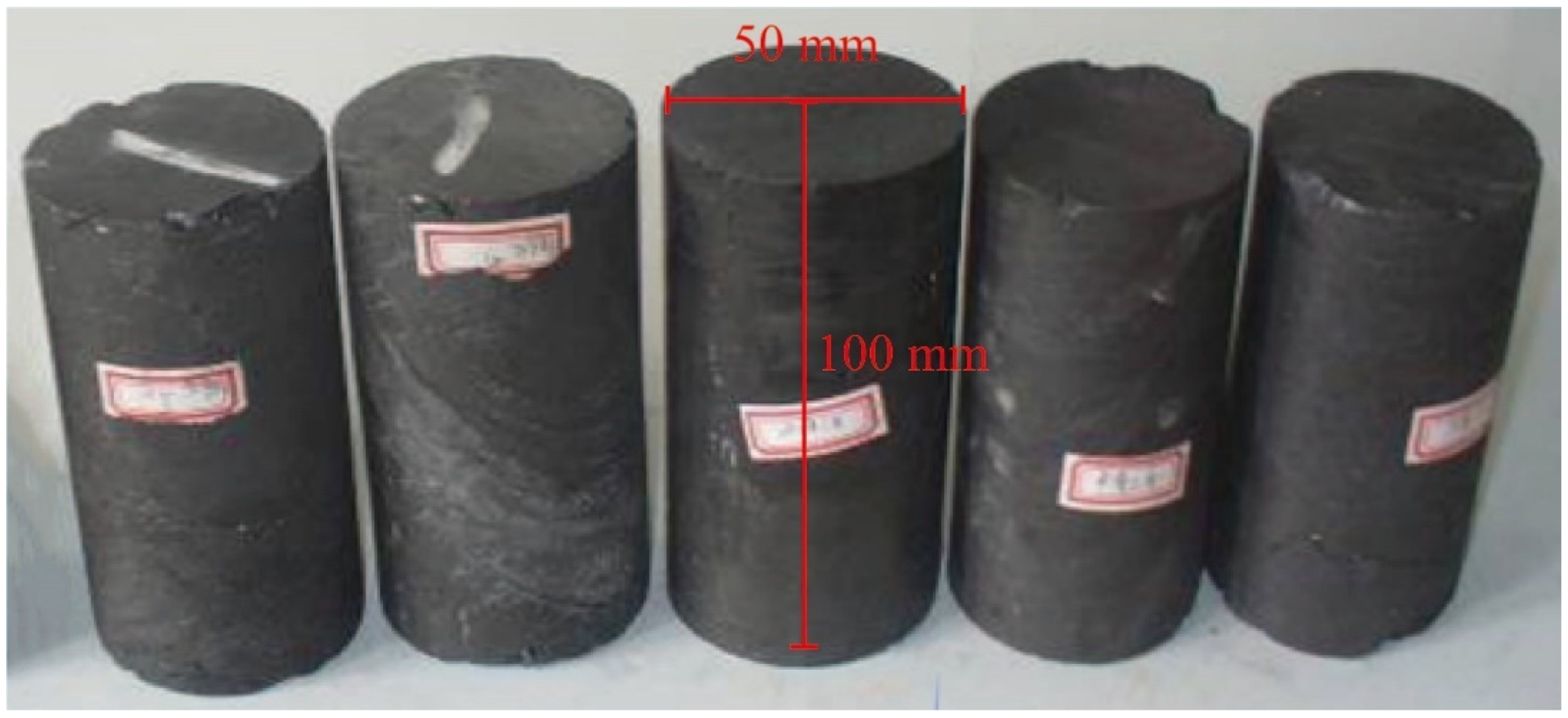
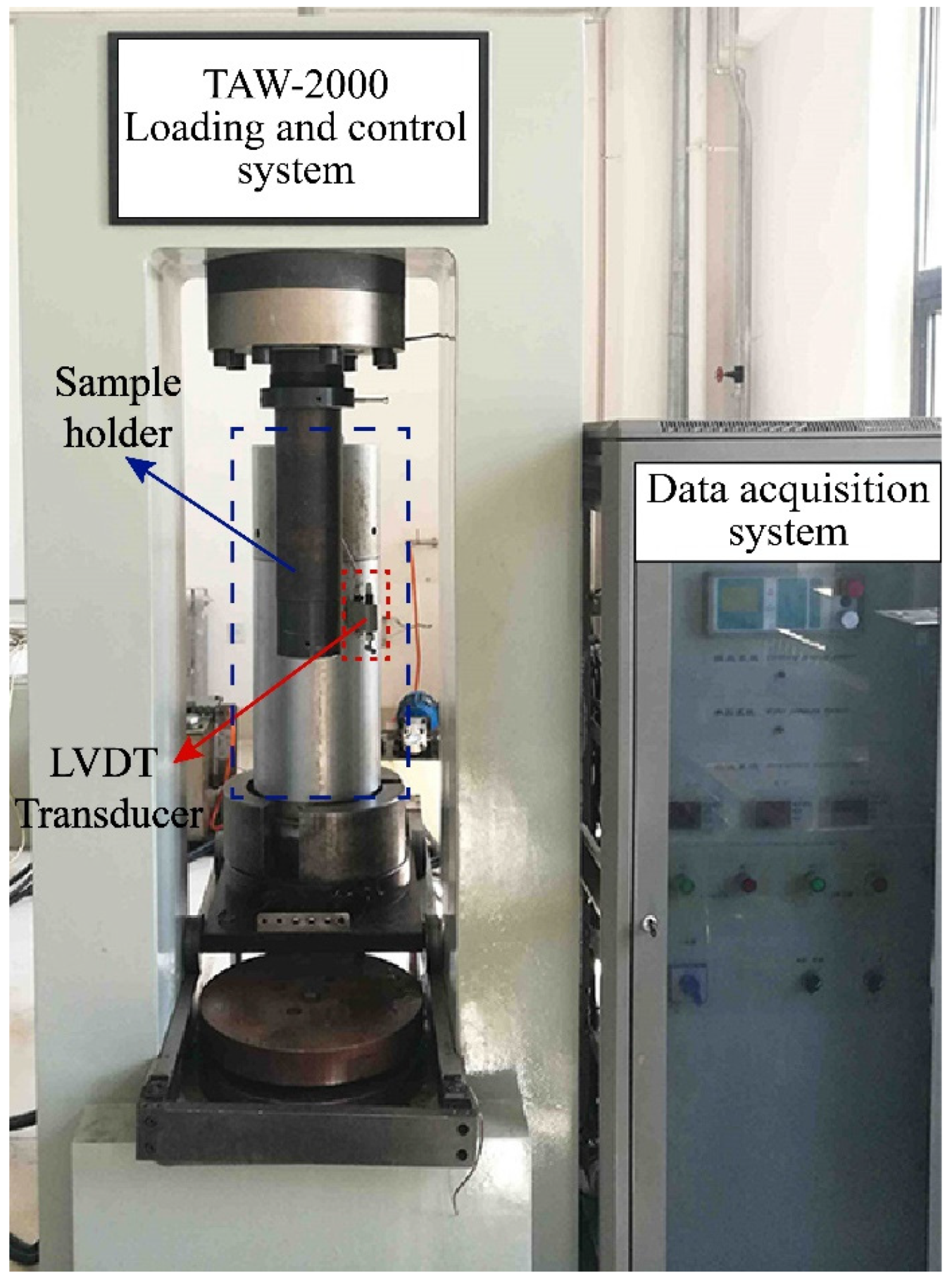
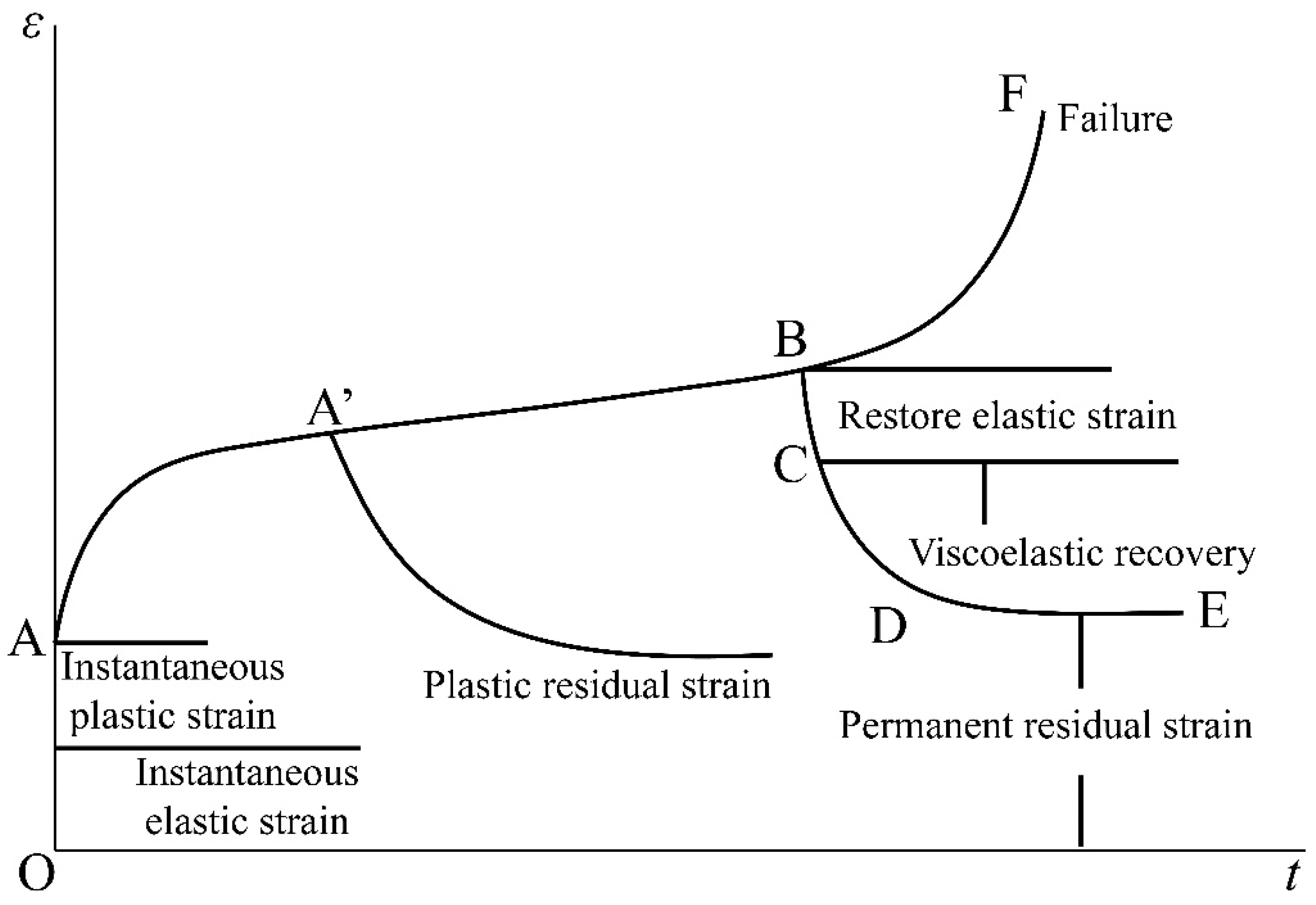
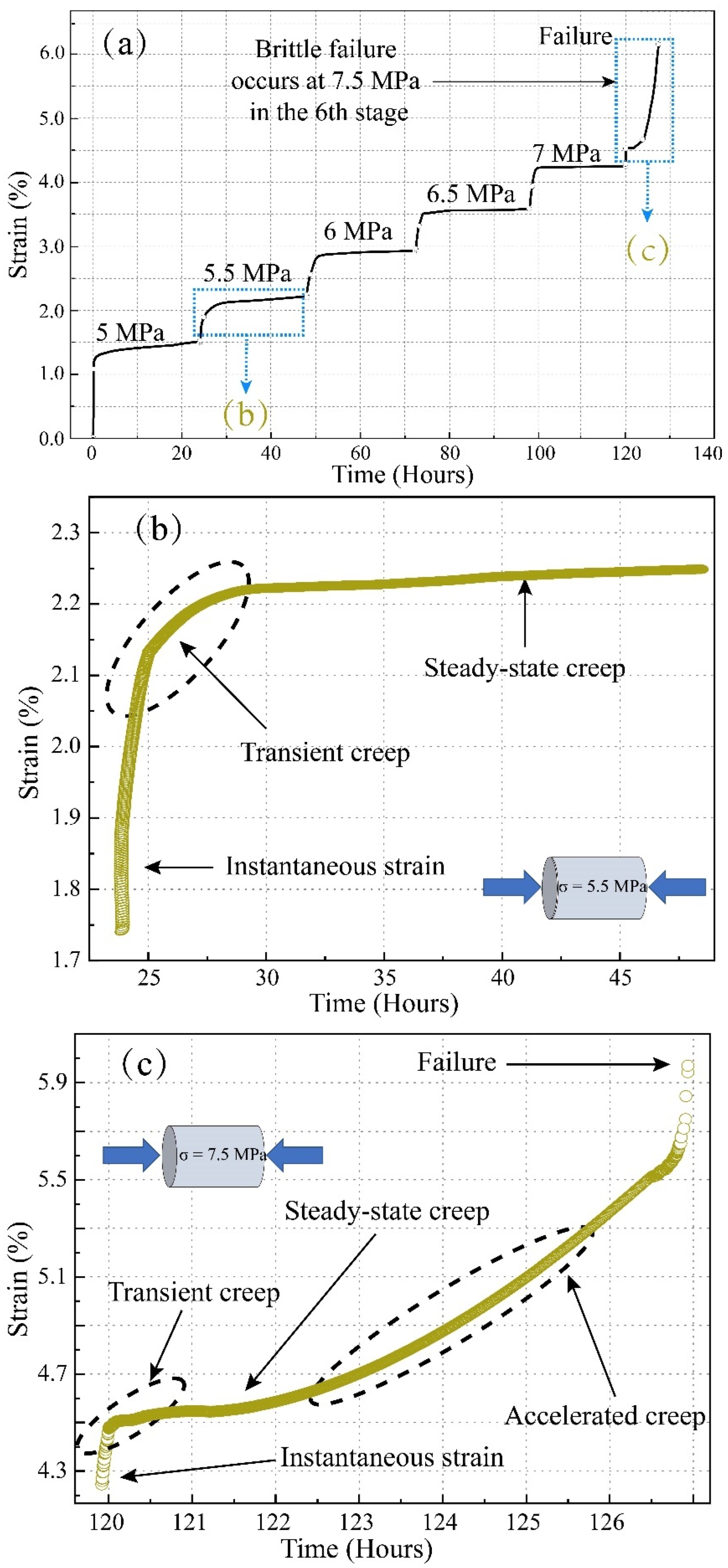
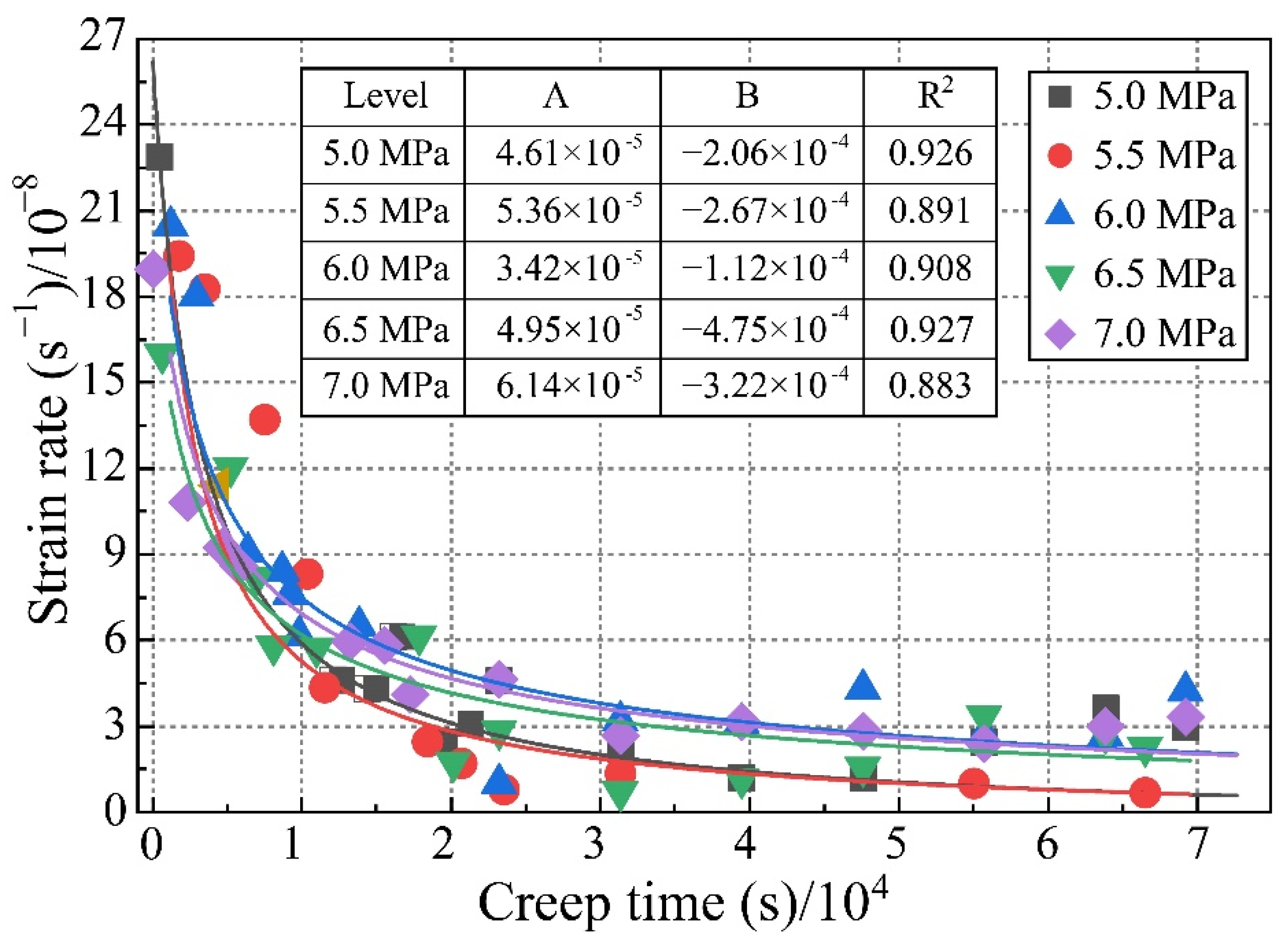
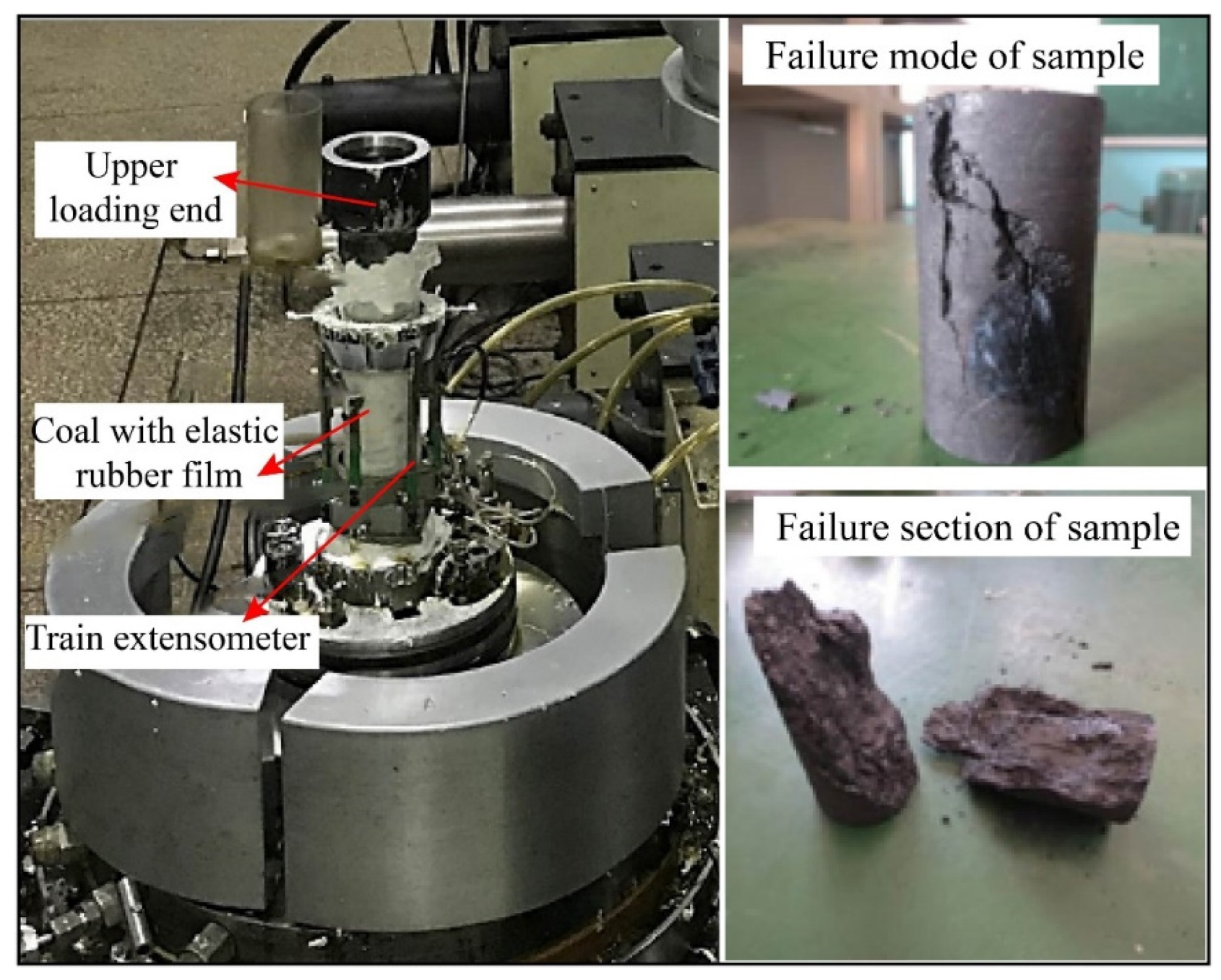
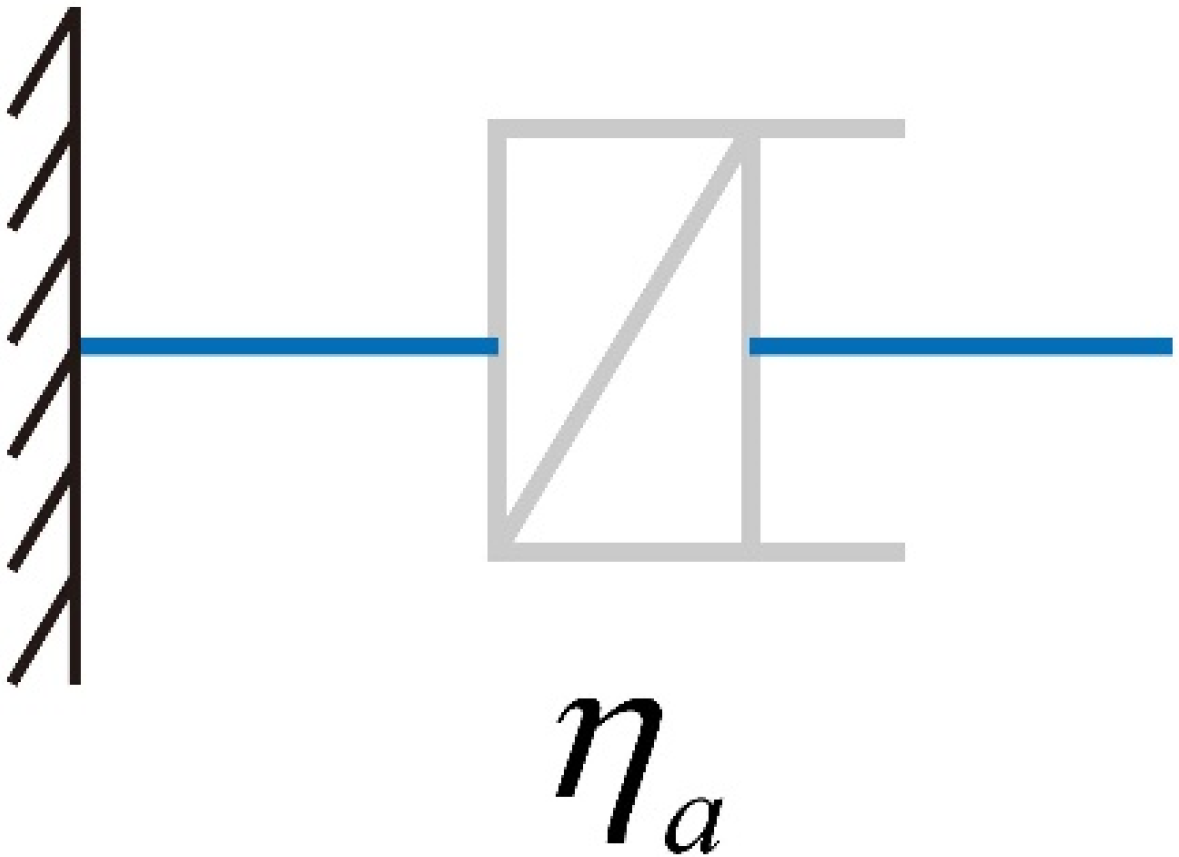
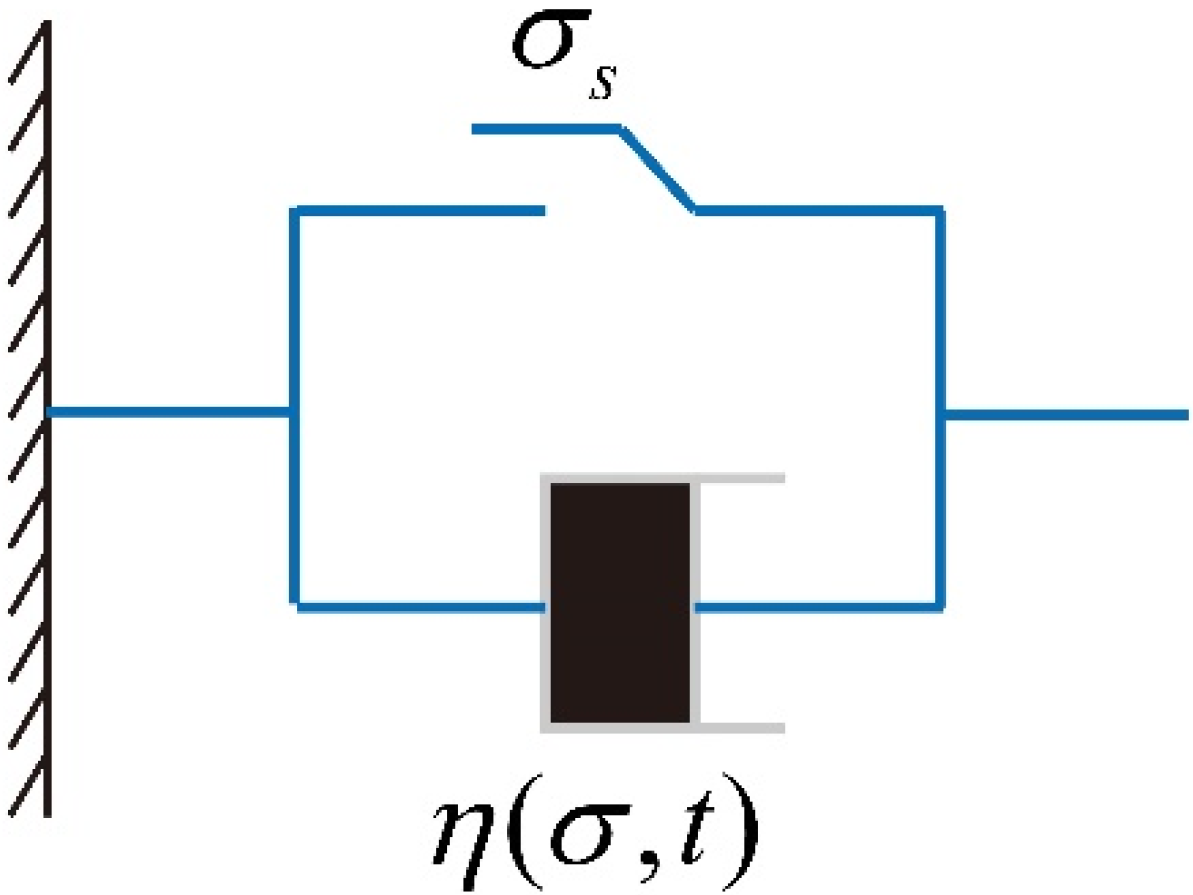
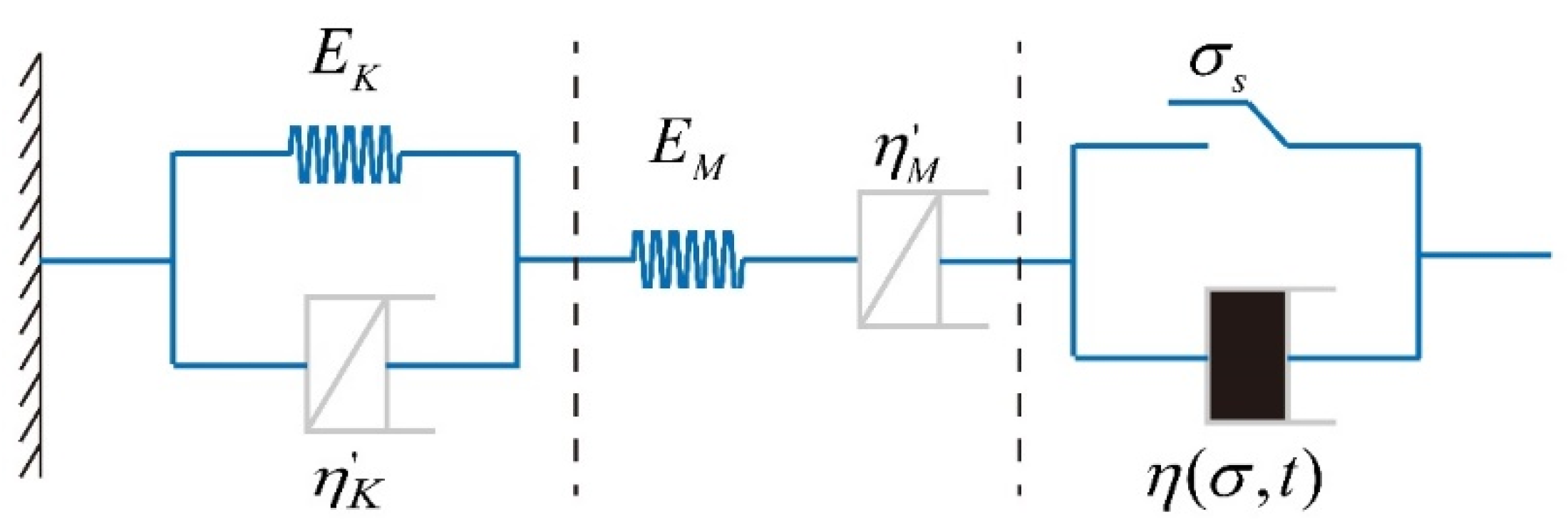
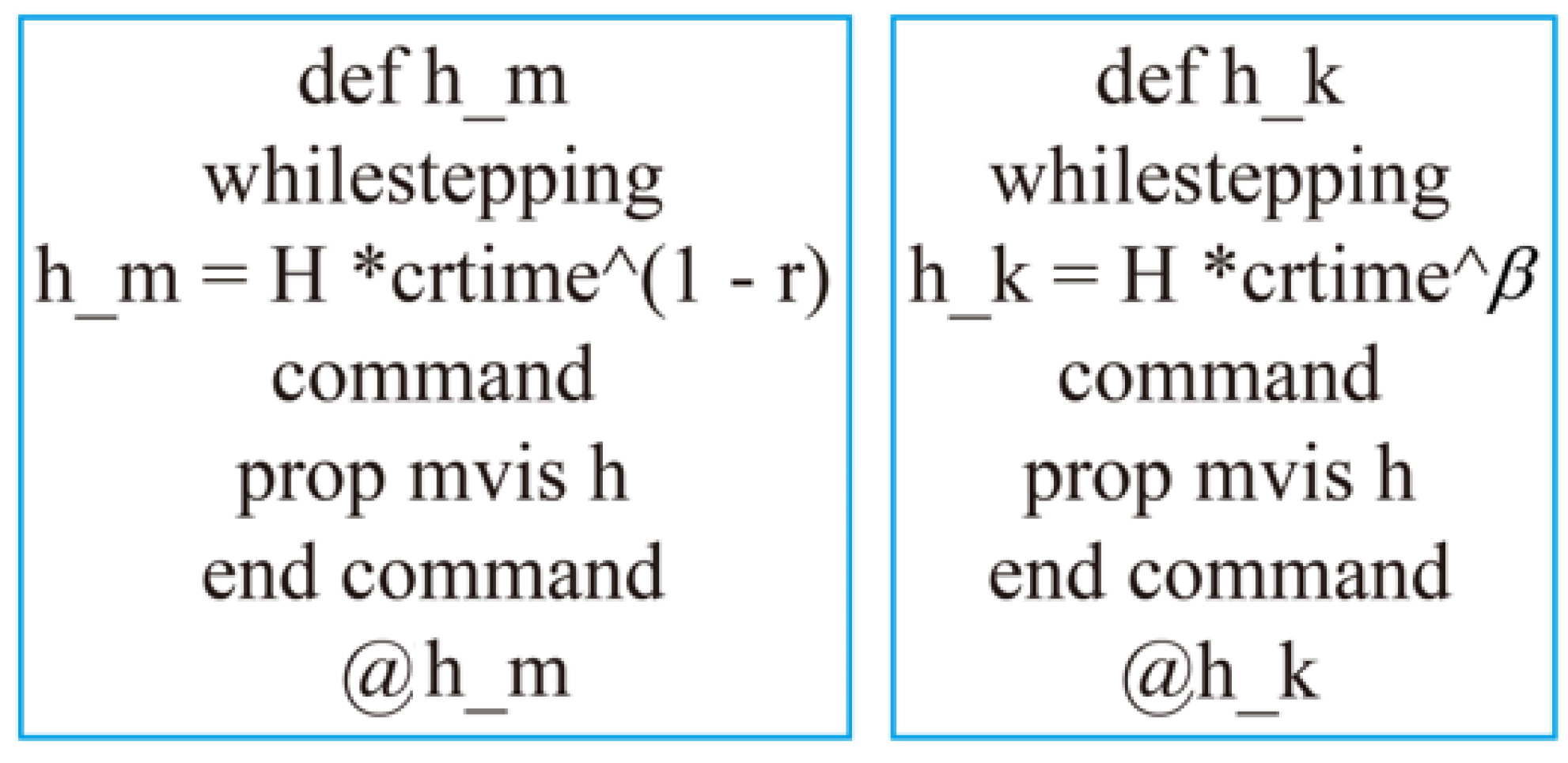

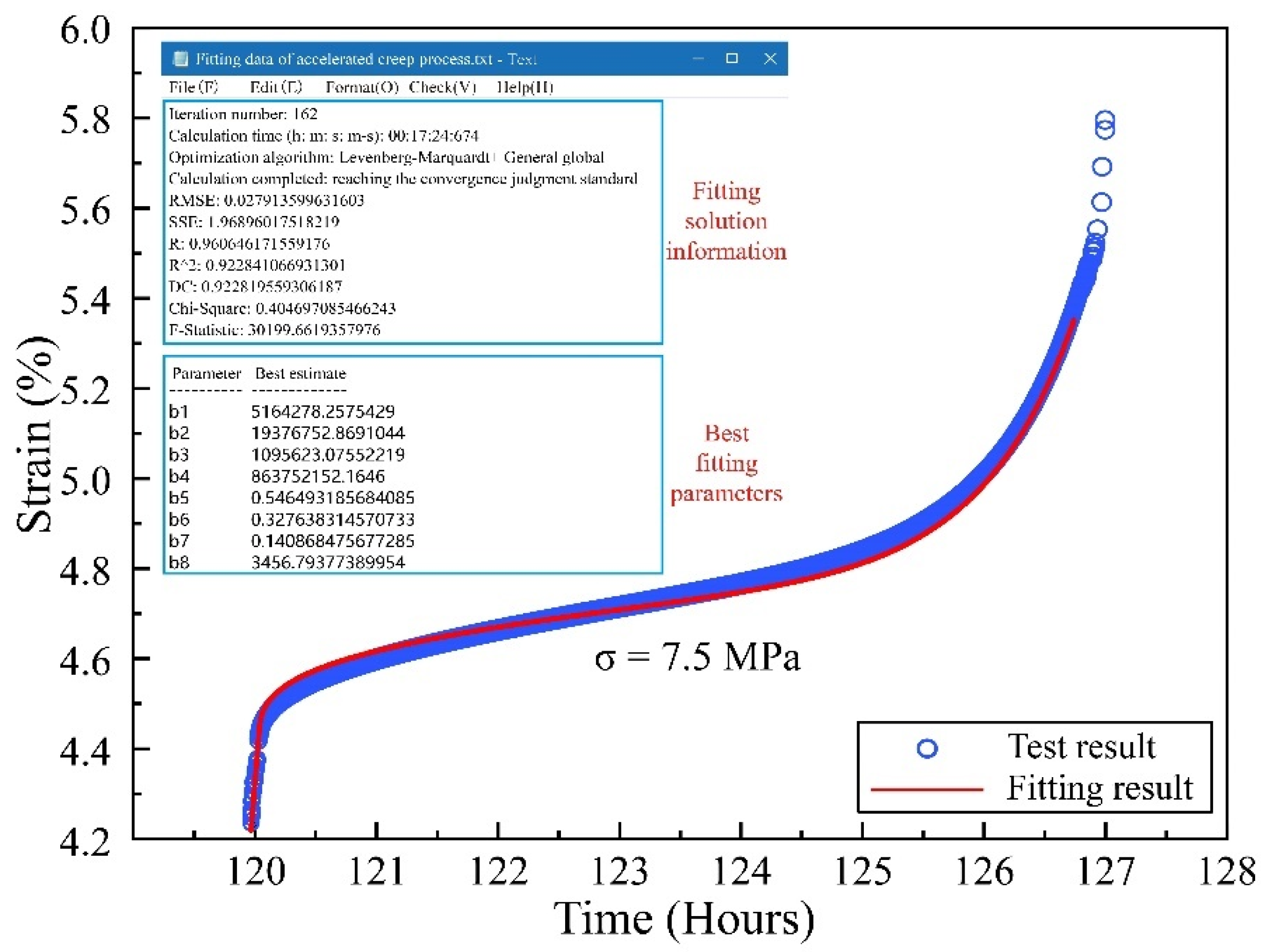

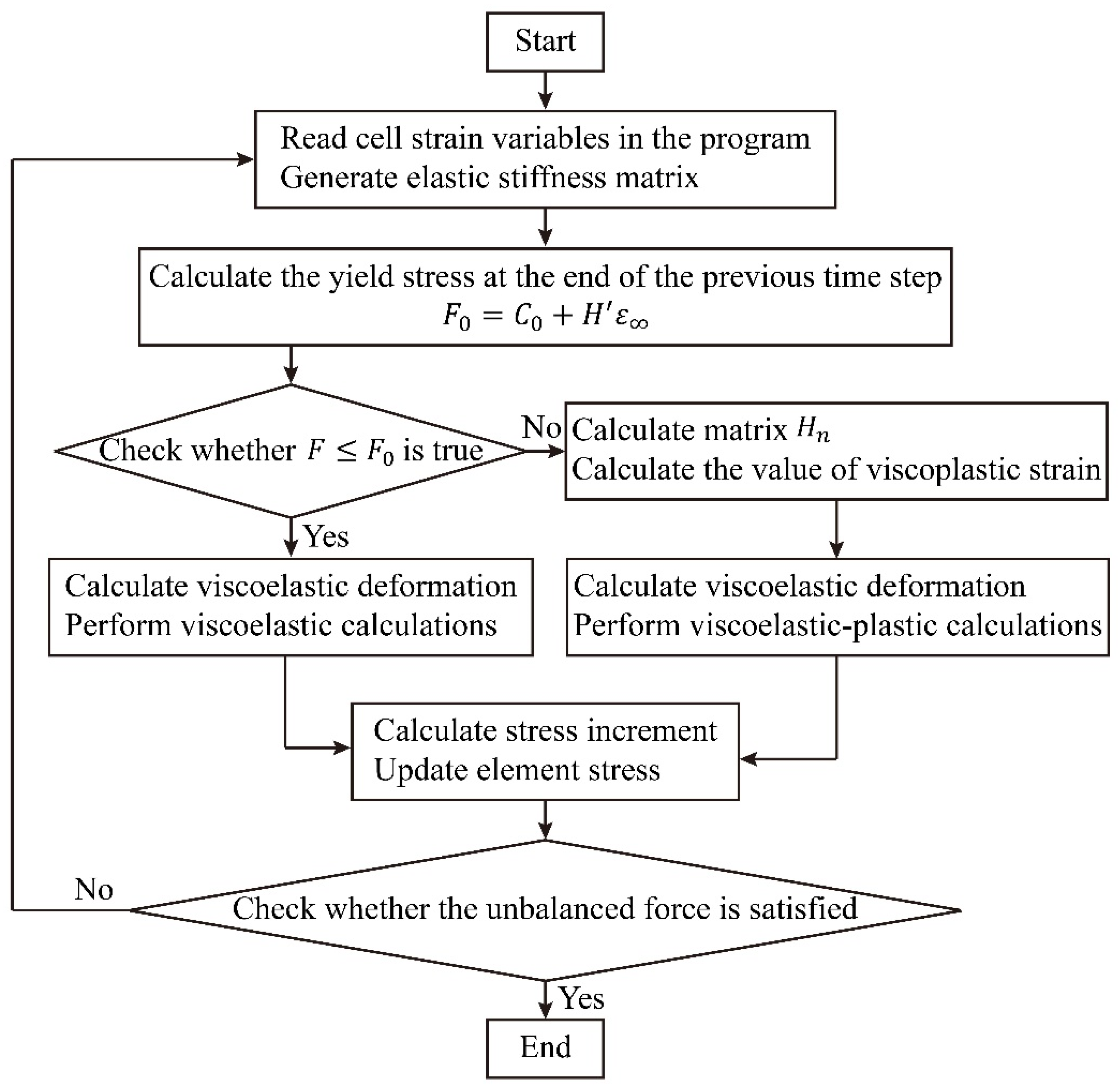


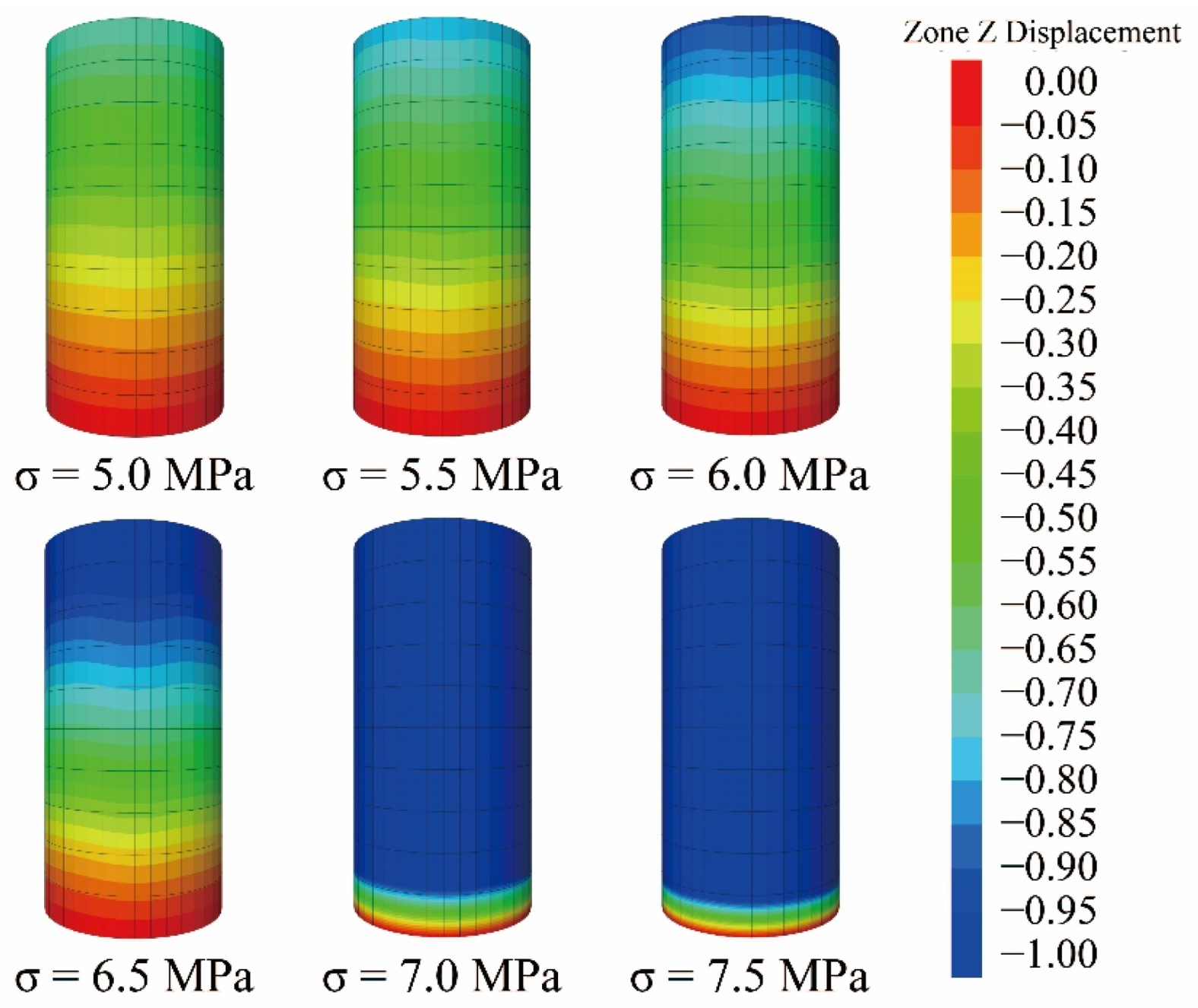

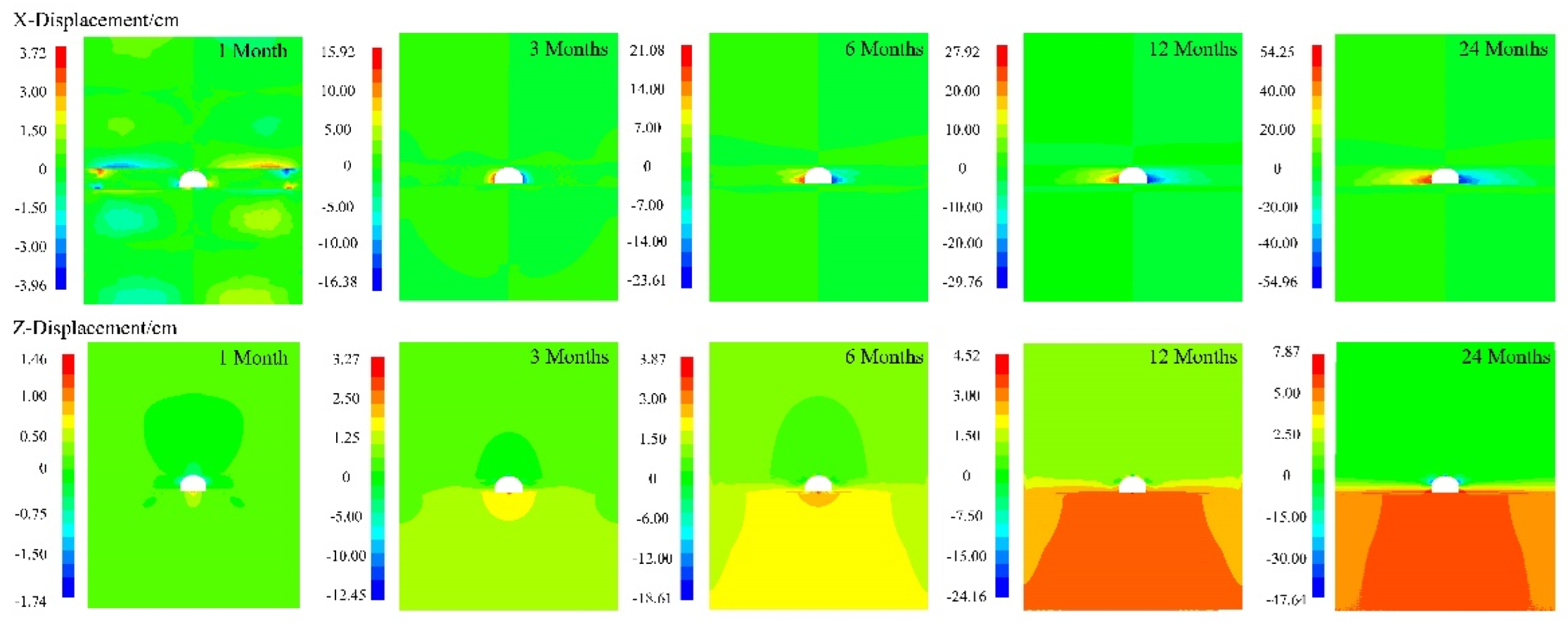
| Samples Number | Samples Size Diameter × Height (mm) | Cross-Sectional Area of Samples (cm2) | Failure Load (kN) | Compressive Strength (MPa) | Average (MPa) |
|---|---|---|---|---|---|
| M-4-1 | 50.80 × 99.50 | 20.268 | 21.93 | 8.50 | 9.986 |
| M-4-2 | 49.34 × 99.92 | 19.120 | 18.39 | 9.62 | |
| M-4-3 | 49.62 × 100.00 | 19.338 | 20.55 | 10.63 | |
| M-4-4 | 49.62 × 100.54 | 19.338 | 19.51 | 10.09 | |
| M-4-5 | 49.22 × 100.48 | 19.027 | 21.10 | 11.09 |
| File Name | Instruction |
|---|---|
| Example_src | User Mohr–Coulomb and User Burgers model source code |
| Axes.h | Defines the coordinate system header file |
| Conmodel.h | Defines the structure of constitutive model data communication |
| Contable.h | Defines the table header files needed for the constitutive model |
| Stensor.h | The header file that defines the tensor |
| Burgers.dat | An example of using User Burgers |
| Udm.sln | The solution required for a custom constitutive model |
| Vcmodels.lib | Custom model required library file |
| Udm.vcproj | Engineering files required for custom model |
| Readme.txt | Description file |
| Coal Layer | Bulk Modulus/GPa | Kelvin Shear Modulus/GPa | Kelvin Viscosity/GPa·d | Maxwell Shear Modulus/MPa | Maxwell Viscosity/GPa·d | Coal Seam Thickness/m | Density/(kg/m3) |
| c3mei | 10.86 | 8.6 | 5.52 | 14.65 | 9.58 | 5 | 1350 |
| c3ding | 19 | 45 | 75 | 30 | 40 | 2 | 2500 |
| c3di | 12 | 25 | 60 | 22 | 20 | 2 | 2350 |
| Rock Layer | Bulk Modulus/GPa | Shear Modulus/GPa | Internal Friction Angle/° | Cohesion/MPa | Tensile Strength/ MPa | Coal Seam Thickness/m | Density/(kg/m3) |
| c1yan | 21 | 17.08 | 34 | 20.6 | 6.71 | 10.5 | 2300 |
| c2yan | 14.65 | 5.62 | 32 | 4.8 | 1.03 | 8 | 2550 |
| c4yan | 12.22 | 9.79 | 37 | 5.15 | 2.6 | 12.5 | 2600 |
| c5yan | 27.35 | 24.05 | 35 | 26 | 8.46 | 10 | 2450 |
Publisher’s Note: MDPI stays neutral with regard to jurisdictional claims in published maps and institutional affiliations. |
© 2022 by the authors. Licensee MDPI, Basel, Switzerland. This article is an open access article distributed under the terms and conditions of the Creative Commons Attribution (CC BY) license (https://creativecommons.org/licenses/by/4.0/).
Share and Cite
Zhang, Q.; Wang, E.; Ding, Z. Research on the Creep Model of Deep Coal Roadway and Its Numerical Simulation Reproduction. Int. J. Environ. Res. Public Health 2022, 19, 15920. https://doi.org/10.3390/ijerph192315920
Zhang Q, Wang E, Ding Z. Research on the Creep Model of Deep Coal Roadway and Its Numerical Simulation Reproduction. International Journal of Environmental Research and Public Health. 2022; 19(23):15920. https://doi.org/10.3390/ijerph192315920
Chicago/Turabian StyleZhang, Qiming, Enyuan Wang, and Zeng Ding. 2022. "Research on the Creep Model of Deep Coal Roadway and Its Numerical Simulation Reproduction" International Journal of Environmental Research and Public Health 19, no. 23: 15920. https://doi.org/10.3390/ijerph192315920
APA StyleZhang, Q., Wang, E., & Ding, Z. (2022). Research on the Creep Model of Deep Coal Roadway and Its Numerical Simulation Reproduction. International Journal of Environmental Research and Public Health, 19(23), 15920. https://doi.org/10.3390/ijerph192315920







